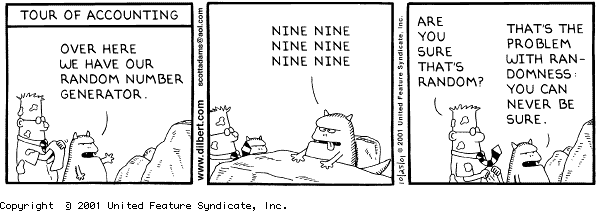
One method of generating unpredictable numbers is to measure the time intervals between decay events of a radioactive substance.
| RANDOM (UNPREDICTABLE) NUMBERS |
|
Random numbers are important in a number of cryptographic
applications, and by random I mean unpredictable in a very
strict sense. The following describes a
random number generator based on an unpredictable physical
phenomenon.

One method of generating unpredictable numbers is to measure the time intervals between decay events of a radioactive substance.
|
| IONIZING SMOKE DETECTOR |
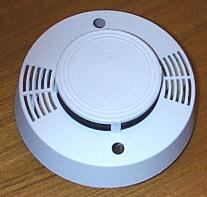 One common and inexpensive radioactive substance is Americium 241,
found in household ionizing smoke detectors.
One common and inexpensive radioactive substance is Americium 241,
found in household ionizing smoke detectors.
Americium 241 is a relatively soft radioactive metal with a half-life of 432.6 years. An average consumer smoke detector contains about 0.3 micrograms of Americium 241 in the form of americium dioxide. It decays to Neptunium-237 by emitting an alpha particle, with a by-product (about one percent of the emitted energy) of gamma rays. This decay is unpredicable, so if we have a way of counting and measuring this decay we can convert those data into random numbers. In my set-up I use a First Alert model SA301B battery-operated smoke detector, basically because it was handy. Please use a detector that is not needed to protect a dwelling. They're pretty cheap and no-name brands are available at Home Depot or other home improvement stores for well under $10. Note that the ionizing smoke detector contains radioactive material, not the photoelectric ones (unless they are the expensive dual-method detectors). The radioactive ones are easy to spot because they have unusual warnings on the label, as seen here.
|
| DISASSEMBLING THE SMOKE DETECTOR |
|
First of all, it should go without saying that if you decide
to actually attempt any of these actions that it is entirely
at your own risk. I cannot be responsible in any way for
any problems or injuries you may experience. If your house
goes up in smoke and you glow in the dark for the rest of
your short life, it's not my fault. I am simply describing
what I have done -- I am not encouraging anyone to do anything.
I disclaim everything.
|
| MEASURING THE RADIOACTIVITY |
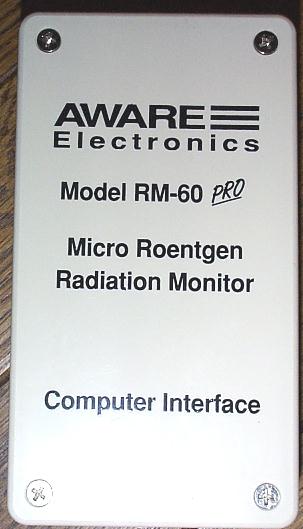 Now that we have a source of radiation, we need something to
measure it with. I use a model RM-60 Micro Roentgen Radiation
Monitor from Aware Electronics.
This unit is powered via a serial interface and
uses four pins on a DB9 connector:
Now that we have a source of radiation, we need something to
measure it with. I use a model RM-60 Micro Roentgen Radiation
Monitor from Aware Electronics.
This unit is powered via a serial interface and
uses four pins on a DB9 connector:
To start taking measurements, raise DTR to power the RM-60. After a five-second charging period, the RM-60 will toggle the Ring (RI) indicator pin each time it detects a particle.
|
| MOUNTING THE PIECES |
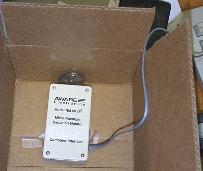
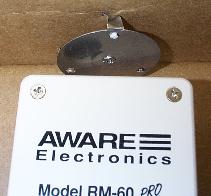 The most expedient method of mounting for me was to use an
empty cardboard box, just large enough to hold the RM-60.
The chamber mounting legs are sharp enough to dig into the cardboard
and hold it vertically. The sensor can be aligned
so that the port will be just a few centimeters away from
the radioactive source.
The most expedient method of mounting for me was to use an
empty cardboard box, just large enough to hold the RM-60.
The chamber mounting legs are sharp enough to dig into the cardboard
and hold it vertically. The sensor can be aligned
so that the port will be just a few centimeters away from
the radioactive source.
The distance between the sensor and the source doesn't have to be exact. It needs to be close enough to receive particles fairly frequently yet not so close that the activity rate exceeds the timing ability of the computer. I adjusted the distance to get a fairly rapid (about 5 to 10 clicks per second) activity result from the sensor.
|
| PROCESSING THE MEASUREMENTS |
|
I have my RM-60 connected to the serial port of an old 486 PC running
DOS.
I wrote a C program to raise DTR, monitor RI and report the
number
of milliseconds between each detection. I use a timer source
driven from the PC's 8259A Programmable Interrupt Controller
rather than the standard DOS clock() to get better resolution
(the DOS clock
ticks about 18.2 times per second, which masks a lot of the entropy
we're trying to measure).
The result of these measurements is a stream of time intervals between detections. Click here to see an example file that contains an hour's worth of raw timer intervals. The least significant bit of the time interval is considered the "random bit." An easy way to think about this is that the absolute value of the timing measurement is not important -- the only characteristic we care about is whether the interval value is even or odd. It is possible that the timing measurement has a bias. Said another way, it's possible that the intervals may have many more odd numbers than even, or vice versa, due to some internal behavior of the hardware or software. So, rather than using the least significant bit directly, we take a pair of bits from two adjacent values and de-skew them by taking the result according to this table:
What this essentially says is that if one time interval and the next time interval are both even or both odd, both intervals are thrown out. If the first interval is even and the second interval is odd, a '0' is output as the random bit. If the first interval is odd and the second interval is even, a '1' is output as the random bit. Eight bits from the output of the de-skewing process are placed in a byte and written to an output file. With the current setup I'm averaging about 10 bytes (80 bits) per minute into this file, or about 14 kilobytes of random data per day. Click here to see an example file that contains an hour's worth of de-skewed bits derived from the earlier interval examples. A separate program takes batches of 2048 bits (256 bytes) from that file and passes them into the Secure Hash Algorithm (SHA-1), resulting in an output block of 160 bits (20 bytes). Click here to see an example file that contains the output from the SHA-1 algorithm using the previous example de-skewed bits. These bytes are then used as keying material for cryptographic operations.
|